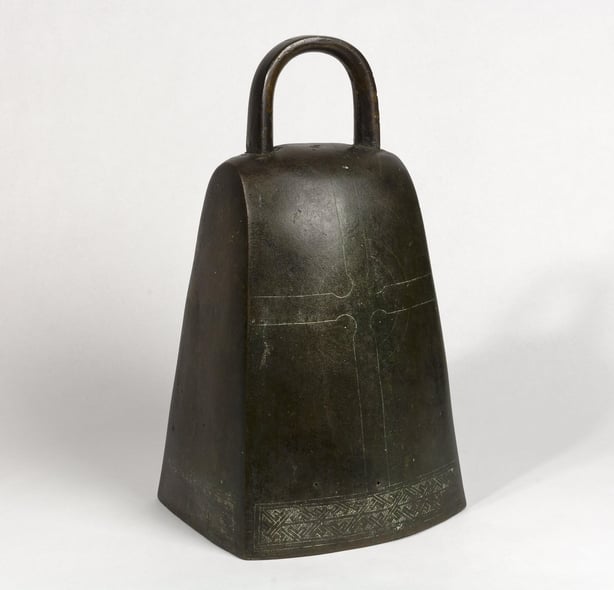Analysis: An exhibition allows visitors to experience a small part of medieval Ireland as it was heard more than 1,000 years old
The Ireland and the Birth of Europe exhibition at the Hunt Museum in Limerick highlights a number of extraordinary medieval artefacts from its collection. This exhibit emphasises the role networks of Irish Christian scholars and missionaries played in shaping the intellectual landscape of medieval Ireland and Europe following the collapse of the Western Roman Empire and the emergence of new socio-political entities in and around the time of Charlemagne.
Among the treasures are four 9th-century medieval Irish handbells, captivating objects that highlight an important Irish contribution to the material history of Western European civilization. Visually, the bells are intriguing. Each is four-sided, resembling an elongated cowbell: a small brass bell from Co Meath; a more rectangular monastic handbell from Co Westmeath; a bell found in Bray, Co Wicklow and the highly decorative Cashel Bell. Two of the bells in particular—the Bray Bell and the Cashel Bell—demonstrate a remarkable level of medieval metal craftsmanship.
These objects have another aspect to their identity, as they give us an auditory glimpse into the past. As the bells are more than 1,000 years old, it's probably not a great idea to sound them too often. Already, centuries of wear and tear have taken a toll on each bell. For example, the monastic bell has several significant dents, as does the Bray Bell, and the Cashel Bell had a very inauthentic handle replacement in the early 20th-century. In addition, all of the bells are missing their clappers. Again, the Cashel Bell had a new one attached along with the updated handle.

These alterations inevitably affect the sound of the bells, but not to the point that all is lost. Think of it as how a painting or fabric loses some of its color vitality over time, yet much of the original is still preserved even in its changed state. The most important factors that influence the sound are the geometry of the bells’ surfaces, the mass of the bronze that makes up each bell, and the energy that is injected into a bell by way of the strike that sounds them. These factors are, for the most part, intact or can be easily simulated.
In 2022, a recording session at the Hunt with museum staff Sian McInerney and Sinéad Hutchison and myself captured the sounds of each bell. Different percussion mallets and objects were used to carefully hit the points where the original clappers likely struck. The goal was to produce what we felt was the clear and full sound of each bell.
In the case of the Cashel Bell, we also recorded a peal with the current clapper to get a sense of how the bell responded to multiple strikes in a short time period. Due to its weight, it took a surprising amount of effort to do this. It is a bell that requires serious intent from the player to get it to sound!
These recordings—the aural identity of each of the bells—are now available for visitors to hear via an interactive iPad interface at the museum. While it is possible to create more exact sound models of each bell, it would take a lot more resources to make the necessary acoustic measurements, digitally reconstruct authentic clappers and even digitally remove the dents from each bell. For now, we have provided an accurate and valuable approximation of the original sounds of the bells, offering a auditory connection to the past, allowing visitors to experience a small part of medieval Ireland as it was heard centuries ago.
Back then the sounds of these bells could signal several different things. I would highly recommend Cormac Bourke's Early Medieval Hand-Bells of Ireland and Britain, which catalogues over 300 similar bells, and also discusses the contexts—real and mythological—in which these bells were originally used.
Sometimes, the bells were used very practically, simply marking out the different parts of the early Christian monastic day. At other times, similar bells were said to have been used to cast out demons or function as relics that helped cure sickness. Indeed the square bell of Saint Goulien in Britany is still used today in blessings.
From The Society of Antiquaries, Cormac Bourke discusses early ecclesiastical handbells in Ireland and Britain
My own favorite early Irish bell story relates how a boulder with a golden bell on top of it floated across the sea, following St. Declan as he sailed from Wales to Ardmore in Waterford in or around the 5th-century. Visually, imaginatively and, now once again, sonically, these wonderful bells continue to sound across the ages.
While the interactive iPad interface provides a modern means to experience these sounds, it is not going to last for another 1,000 years, and likely not much beyond 20! The digital code, like the vellum produced by early Irish scholars and the handbells at the Hunt museum, may endure, but its accessibility for future generations is highly uncertain.
The original creators and users of these bells could never have imagined the ways in which we now encounter them today. So what are we now bequeathing to our descendants? Some of it may well resonate across Europe 1,000 years from now.
Follow RTÉ Brainstorm on WhatsApp and Instagram for more stories and updates
The views expressed here are those of the author and do not represent or reflect the views of RTÉ




